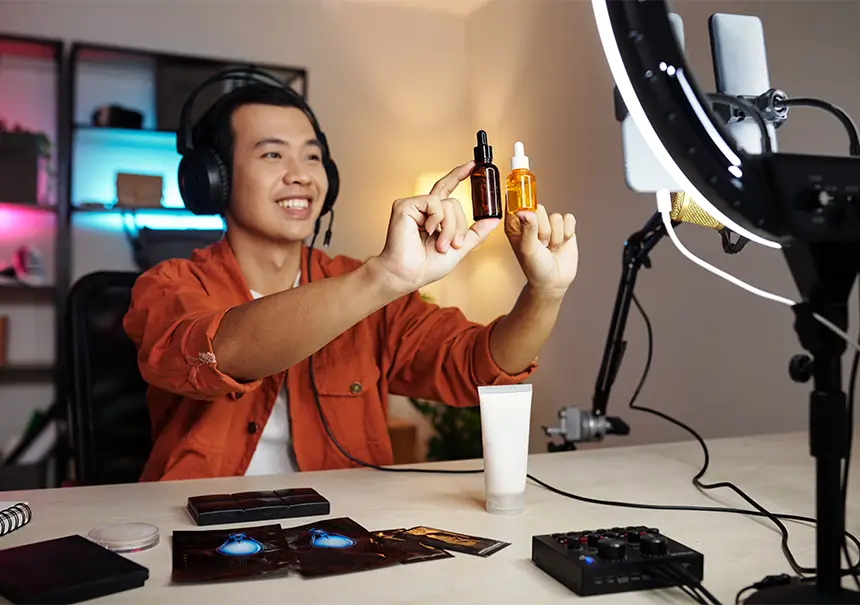What is CTR and how to improve click-through rate?

Online advertising is all about…clicks. A click means that a potential customer, upon seeing an ad creative, became interested enough to move on. A click is an increase in website traffic, brand awareness and a chance to improve sales results. CTR measures the effectiveness of your campaigns. Let’s see how click-through rate is calculated and how to get a satisfactory CTR.
Theory. Definition of CTR
Click Through Rate, or click-through rate in Polish. A measure commonly used in Internet marketing. The formula for calculating CTR is child’s play: the number of clicks on a link or ad in relation to the number of impressions. CTR values are expressed as a percentage by dividing the number of clicks by the number of impressions. So, for example, if an ad is displayed 1000 times and 100 people click on it, the CTR result will be 10%.
To some extent, your conduct in future advertising campaigns depends on the CTR. A low CTR is a yellow card: your ad may not be very captivating or enticing to click on, or you may have to sit in the Google Ads panel longer and narrow down your target audience so that your ad displays to the right people. A high CTR, on the other hand, is proof that the campaign has been well thought out, the ad slogans or graphics are attractive to users, and the target audience is properly selected. Of course, you shouldn’t settle on your laurels, but keep trying to figure out how to increase this click-through rate – after all, the end result should be satisfactory sales.
Use of CTR. What is the importance of a high CTR?
As we said, the Click Through Rate gives the answer to whether an advertising campaign is effective. If you manage to improve the Click Through Rate, several rewards await you. More traffic to the page to which the ads lead is obvious. If the site is done with a head, has a good UX and encourages people to buy, you can also expect an increase in conversions (of course, this does not depend only on the quality of the site). Ads that see an increase in CTR can be cheaper – so don’t hesitate to use historical data on CTR levels to optimize your next campaigns. Adhering to the subject will help you avoid burning through your advertising budgets.
How much is a good CTR? There is no universal answer. A satisfactory CTR depends on your industry, target audience or competitor activity: in some cases, when you advertise for popular keywords, it may be more difficult to break through with your campaign, especially if other marketers have larger budgets.
A high CTR means more clicks, meaning more traffic “flows” to your site. And this is beneficial from an SEO point of view, i.e. positioning of the site. Google’s algorithm sees this increase in visits and recognizes that the domain is valuable, so it enjoys increased user interest. Of course, remember – online ads are no substitute for good old SEO, done organically at the grassroots. These are additional and complementary activities. You will achieve much better SEO results by pursuing a long-term strategy to build the credibility of the domain – after all, in the future you may decide to give up or reduce online advertising, and then the site will cease to be powered by more traffic and will inevitably drop in search results.
High CTR. How to achieve it?
Increasing the CTR value is doable, but it requires some work on your side. As it is in marketing: we advise you to test, test and test again which solution will work best. We know from experience that using several strategies at the same time can increase the CTR of a campaign.
Let’s start with the basic thing that should improve your CTR from the get-go. The right target audience is the key to success. Sure, it can be argued that the more the audience of an ad, the greater the chance (mathematically speaking) that more people will click on it…but remember that you should also interpret the CTR by the number of impressions. With a vague, broad target audience, the impressions will certainly be more, but that doesn’t necessarily translate into a CTR click-through rate.
You can tailor your audience based on what they are interested in or search for online with the help of Marketing Automation. iPresso’s integration with the Google Ads ecosystem allows you to transfer ready-made customer segments from your database (already sorted, just by interests and activities) to your ad panel and create personalized, tailored campaigns for your audience. The better matched the target group, the greater the chance of clicks and, consequently, an increase in CTR.
In addition to a tailored audience, your campaign needs an engaging creative. Depending on the type, the ad can be text only, or text mixed with graphics. Either way, it’s worth doing something to stand out and reach (at least) an acceptable CTR.
Another important point: keywords. A lot depends on the industry. In some businesses, competition is fierce – it will be difficult, starting from scratch, to strike out quickly for the phrase, let’s say, “cosmetics.” It is not impossible, but it takes time and patience. However, well-chosen keywords plus systematic targeting of ads under these phrases, combined with quality advertising creative can bring you a satisfactory CTR.
And don’t forget to test different versions of the creative. The Google Ads dashboard directly encourages this. You can leave it in the hands of the algorithm to choose a more effective ad on its own, but we recommend increasing the CTR with your own experiments – it’s always an opportunity to learn something new.
A decently done landing page can also increase CTR. In addition to adapting it to SEO requirements (such as page load speed, light weight images, meta descriptions, saturation with relevant keywords, providing valuable inbound links, etc.), it should be aesthetically pleasing and encourage people to take an action – be it signing up for a newsletter or making a purchase.
Remember, even high CTR values mean little to the business if the landing page is of poor quality. We take care of the landing page at the beginning, before the start of the advertising campaign, so as not to waste time and burn through budgets.
In summary: partido a partido
That is, match by match, as Diego Simeone says. Don’t do everything at once. Start with an optimized, polished landing page. This is where the final goal happens: sales.
Take the time to select the right target audience – not too broad, don’t lump all customers together. A sensibly created audience is a chance to increase your CTR.
Take the time to mull over ad creatives, testing different versions until you find the ones best received by customers. A better ad creative is a marching improvement in CTR.
Take the time and don’t be afraid to use Marketing Automation. This strategy has it in its DNA to ensure a high CTR and increase sales.
Try the marketing automation platform for 30 days for free and see for yourself that it works.




